When it comes to architectural coatings, some architects and designers might think they know everything there is to know. But there’s more to the expansive industry than meets the eye. The vibrant history of coatings, technological innovations, and color trends that reflect our culture all combine to create today’s evolving coating landscape. Here are six things you might not know about architectural coatings.
1. Color experts forecast trends years in advance.
We’re used to hearing ‘Color of the Year’ announcements from paint companies and color experts in industries such as fashion and horticulture each year, but the work of color forecasters goes far beyond predicting a year or two ahead.
At Valspar (becoming Sherwin-Williams Coil Coating), color strategist Sue Kim says color experts predict out about 8 to 10 years in the commercial building market compared to 2 to 5 years in the residential market. It makes sense: Homeowners like to switch up the look of their spaces, while buildings such as hospitals have more rigid rules and considerations for how color is utilized.
2. Valspar’s Fluropon® line came from a resin initially intended for engineering applications.
Fluropon, the first 70 percent PVDF coating in the industry, was introduced in 1965 after a paint chemist realized PVDF resin—originally intended for use as an engineering resin for piping and valves—would make a durable paint. Now an industry standard, the Fluropon line brings brilliant color and lasting protection to metal building materials and can be found applied on buildings all around the world. And when it was first introduced, the line offered just five colors. Today, it has expanded to offer more than 25,000.
3. Toxic releases by the paint and coatings sector decreased by 81 percent between 1990 and 2014.
The U.S. Environmental Protection Agency’s Toxic Release Inventory shows that releases by the paint and coatings sector are decreasing. The architectural coatings industry is getting more environmentally friendly all the time. As the use of architectural coatings has increased over the last few decades, volatile organic compound emissions have drastically decreased over that time period.
4. Paint has been around for about 30,000 years.
Neanderthals used minerals and other natural sources to spice up their cave dwellings more than 30,000 years ago. Paint as an industry has its roots in the 1700s in Boston, where the first-recorded paint mill was established. The first ready-mixed paints in the U.S. were patented by D.R. Averill of Ohio in 1867. The industrial revolution gave rise to the growth of the paint industry, which now offers architects and homeowners endless options for bringing more color to their exteriors.
5. The architectural coatings industry is worth more than $11.2 billion.
This 2015 statistic from the American Coatings Association shows just how massive the architectural coatings industry has become. Architectural coatings comprise more than half of the paint industry, making it the industry’s largest segment.
6. Innovations in metallic coatings mean a topcoat is often no longer needed on a project.
For decades, the industry standard for metalescent pigments was to use flakes of aluminum to achieve sparkling metallic effects in paint. But aluminum is prone to oxidation, meaning it degrades when exposed to the environment. Because of this, a three-coat system became standard: a primer, color coat, and a protective clear coat on top. Now through the use of mica, a stable and inert mineral, paint developers can add a sparkle to a coating and bypass the need for a topcoat. Using mica, paint chemists can also develop a wider range of colors and special effects that will perform on exteriors.







